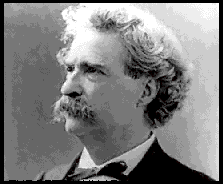Samuel Clemens, Local Color, and the Nature of Humor
Local Color Writing
- Attempts to picture the language, culture, and geography of a certain region
- Tends to be humorous and/or sentimental in its portraits of daily life
- Often relies on dialect, particular mannerisms, and eccentric characterization
- While it is both a species and (in some cases) a precursor of Euro-American Realism, it does not attempt the high seriousness noted for realism; instead, it tends to focus more on atmosphere and personality sketches.
- It does reject the dominance of European, and particularly British, settings for fiction.
- It also rejects Romanticized notions of plot and character
- Its purpose is more to entertain than to inspire or educate.
- Most of it grew out of short stories published in circulating magazines and newspapers.
Observations from Clemens' "How to Tell a Story"
Humorous Story
- American
- Stresses manner of telling
- Willingly wanders from place to place with little apparent structure
- A particular kind of art needed
- Oral in its origins
- Told seriously with an attempt to hide the humor
- Ends with a "nub" or "snapper", an unexpected trick on the audience. Must carefully manage the "pause"
Comic or Witty Story
- British or French
- Stresses subject matter
- Must have a brief, concise pattern
- Clemens insists no art is needed
- Perhaps writterly in its creation
- Told with comedy clear and present
- Doesn't attempt to hide the point
Questions
- What are the elements of local color (particular regional language, eccentric characterization, and/or sentimental detail) in "Jim Smiley," "The Story of the Old Ram" and "Buck Fanshawe"?
- How do they represent, according to Twain's definitions, examples of humorous instead of witty stories?
Look over the material from "The Nature of Humor." Pay close attention to the basics regarding how humor works and the ethics that humor can practice. We will use the theology material next week with Twain.
Questions
- What kind of ethical responses does Twain's humor encourage in his audience? Name some examples.
- Identify the type or types of humor (cf. Fowler chart) present in the following stories by Twain. Be sure to point to specific examples from the text to support your point:
- "Pudd'nhead Wilson's Calendar" (195-199)
- "Cannibalism in the Cars" (28-36)
- "Map of Paris" (53-58)
- Whittier Birthday Speech" (134-139)
- "A Cat Tale" (145-155)

